ON THE BRINK
WINS SPECIAL MENTION AT
2003 HONOLULU FILM FESTIVAL
Pictures
and Text: ENDANGERED SPECIES OF NE NSW
&
8 EXTINCT AUSTRALIAN SPECIES
“ON THE BRINK” protects 180,000 acres of NSW oldgrowth forests
Endangered Species Project
The Endangered Species Project raised awareness and sympathy for
endangered species in the run-up to the NSW state elections in March 2003.
Australia has an abysmal record on species
extinction. More mammals have become extinct in Australia over the last 200
years than in any other country in the world. Many other species which live
in our forests and woodlands are now in severe decline. This is particularly
the case with most of the 300 Australian animals and birds that use tree hollows
to nest and find shelter. Hollows only form in trees older than 120 years. Destruction
of habitat and old trees has to stop if we want these species to survive. The
Threatened Species Conservation Act 1995
lists 80 animal and 300 plant species in danger of extinction
in NSW.
,
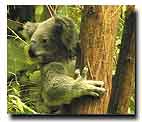
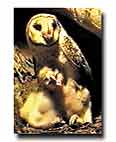
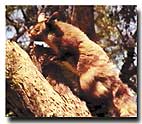
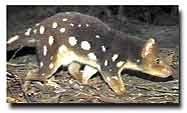
Using Koala, Masked Owl, Yellow-bellied Glider and Tiger Quoll
as examples, the Rainforest Information Centre and friends hoped to convince
NSW decision-makers to protect more habitat to allow endangered forest and woodland
species to avoid extinction.
We presented NSW parliament with thousands of petition signatures to
convince them that they have a mandate to protect habitat on public lands and
to hinder land clearing on private lands in order to prevent the extinction
of yet more of our threatened species.
Fabulous costumes were made with the help of master costume-maker Dale Woodward
and Wollongbar TAFE students. The animals visited schools, hospitals, festivals,
shopping malls etc and starred in a movie "On the Brink" about
their plight.
"On the Brink" stars Sir David Attenborough, David Suzuki
and David Bellamy and features the voice of Jack Thompson as Quoll, Olivia
Newton-John as Koala.
We organised a roadshow
around NSW from Jan March 2003.
The roadshow travelled with the 4 costumes, screened the video "On the
Brink" using a data projector and included local speakers and musicians.
Roadshow dates and venues may be found at
www.rainforestinfo.org.au/spp/roadshow.htm
We estimate that
an average of 40 people attended each event and then over 5,200 attended the
grand finale at The Edge in Katoomba where there were continual screenings for
about 12 hours on March 19 for a total of over 8000 participants. This finale
was attended by Bob Debus, Minister for Environment and he introduced the project
and the video as "a good example of the kind of successful outcome that can
happen when NGO's, the NPWS and Government co-operate on a common task." Debus
accepted on behalf of the NSW government the last of the thousands of petitions
and letters which had been generated by the roadshow. The successful outcome
that he was referring to included the promise by Bob Carr a week or so before
the elections to reserve 15 "icon forests", 65,000 Ha of public lands in NE
NSW which the NE Forests Alliance had identified as the most important unprotected
public lands in the region. It is this very area that David Bellamy was referring
to in "On The Brink" when he pointed out that:
<< In some areas we now have very clear
scientific information about how to protect endangered species. This is the
case in North-east NSW. In 1998, expert panels of scientists commissioned by
the NSW and Federal Governments identified the minimum area of habitat that
must be protected so that populations of threatened animals could survive. For
example they recommended inclusion of sufficient habitat in reserves for;
-
1,224 breeding pairs of Masked Owls, yet only
enough habitat for a fifth of these has been protected,
-
3,781 breeding females of Spotted-tail Quolls, yet
sufficient habitat for less than one fifth of these is reserved, and
- 9,240 breeding pairs of Yellow-bellied
Gliders, in 3 discrete populations, yet sufficient habitat for less than
a fifth of these has been protected.>>
At least 4,000 hectares of undisturbed contiguous forest
should be protected for each Koala population to ensure that a minimum population
of at least 500 individuals is maintained. Corridors are required to link smaller isolated
populations to bigger populations to prevent local extinctions. There has not been
sufficient habitat protected to meet these requirements
In other areas, such as western NSW, there is less
scientific information currently available although it is well known that temperate
woodlands are one of the most endangered ecosystems in Australia. There is less than 8% of
their original distribution remaining. It is obvious that large woodland reserves are
urgently required to protect endangered species.
Extinction rates are some of the highest in Australia,
mammal and bird species are experiencing severe declines and once common species are now
rapidly disappearing. It is obvious that large reserves are required immediately to
protect endangered woodland species.
Urgent changes are required to stop ecosystem destruction in
NSW. The Endangered Species Project is calling on the NSW Government to protect additional
areas of forest and woodland in National Parks to avoid the extinction of the Masked Owl,
Yellow-bellied Glider, Spotted-tail Quoll, Koala and other endangered species.
Now we know what has to be done to avoid species
extinctions. Only the political will is missing. We must change that.
WHAT YOU CAN DO
* Sign a petition to the NSW Parliament. This petition can
be found at
www.rainforestinfo.org.au/spp/petition.htm
* Collect other signatures for the petition. Print copies
from the website and circulate among your friends and acquaintances.
* Write, fax or email Bob Carr: c/- Parliament
House, Sydney 2000, fax 02 9228 3933,
bob.carr@www.nsw.gov.au
* Host a video screening and invite your friends. Send us
your address and a donation and we will send you a copy of ON THE BRINK
* Donate to the Endangered Species Project. Donations over $5 are tax
deductible by sending them to Rainforest Information Centre
PO Box 368 Lismore, NSW 2480
johnseed1@ozemail.com.au
02 66213294
NSW ENDANGERED SPECIES PROFILES

Yellow-bellied Gliders
are the world’s most vocal marsupial. Restricted to tall,
mature eucalypt forests in temperate to subtropical eastern Australia in regions of high
rainfall, their diet consists of sap (80%), nectar, honeydew, manna and insects. The most
proficient glider in Australia, they can cover 144 metres in one bound. In the absence of
trees, the species is unable to disperse among patches of suitable habitat. The
Yellow-bellied Glider is very sensitive to disturbance, often vacating an area when
logging first begins and making little use of young forest even where scattered old trees,
apparently suitable for nest and den sites, are available.

Koalas spend most of the day sleeping, and are active
in the evening. They very rarely drink water, as they get all the liquid they need from
eucalyptus leaves, their exclusive diet. They usually only have one young, weighing less
than half a gram when born. Young Koalas have a pouch life of 5-7 months, feeding on milk
or predigested leaves and leaving the pouch after seven months to be carried about on the
mother's back. By 11 months of age the young is independent. Koalas may live over 10 years
in the wild. Due to commercial logging and clearing of bushland, Koala populations have
been declining rapidly in NSW.

Masked Owls
are amongst the largest and most powerful owls in Australia.
Secretive, relatively silent and strictly nocturnal, they mainly hunt small mammals. They
mate for life. The male prepares the nest in a tree hollow with decaying debris,
preferring the big hollows of trees, usually at a considerable height. Females lay two or
three pearly-white, oval-shaped eggs. She stays in the nest initially with the male
ferrying food to her and the chicks. The young are covered in white down, then a creamy
down and are able to fly at about three months.
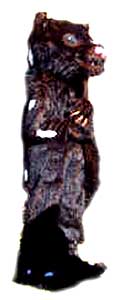 Spotted-tailed Quolls, also known as Tiger Quolls, are the
second largest of the world's carnivorous marsupials. They are brown with white spots on
the body and tail with a moist pink nose, pointy ears and a lot of sharp teeth. They are
solitary, nocturnal animals, very agile both up in the trees and on the forest floor.
Primarily predators, Spotted Tailed Quolls hunt other animals such as rats, birds, frogs,
possums, reptiles, insects, rabbits, mice etc. A Spotted-tailed Quoll can bring down a
wallaby three times its size. Sexual maturity is reached at one year with a life
expectancy of around 6 years. Land clearance and logging have removed or degraded much of
their habitat.
Spotted-tailed Quolls, also known as Tiger Quolls, are the
second largest of the world's carnivorous marsupials. They are brown with white spots on
the body and tail with a moist pink nose, pointy ears and a lot of sharp teeth. They are
solitary, nocturnal animals, very agile both up in the trees and on the forest floor.
Primarily predators, Spotted Tailed Quolls hunt other animals such as rats, birds, frogs,
possums, reptiles, insects, rabbits, mice etc. A Spotted-tailed Quoll can bring down a
wallaby three times its size. Sexual maturity is reached at one year with a life
expectancy of around 6 years. Land clearance and logging have removed or degraded much of
their habitat.
EXTINCTION? YOU CHOOSE
It's not just for the beauty and value of these creatures
that we have to
protect the forests and woodlands:
Forests are the lungs of our planet, they maintain the stability of
climate.
Forests protect our water catchments ensuring clean drinking water as well
as protection from floods and droughts.
Forests contain the genepool that holds the foods and medicines and
industrial products of the future.
Let's work together to keep them alive. Let's protect the forests and their
inhabitants for our children.